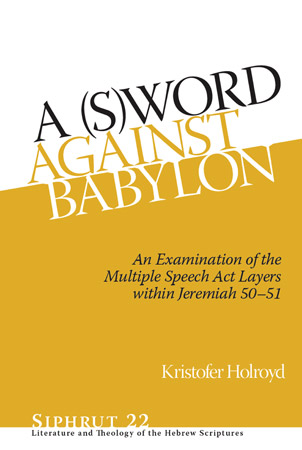
A (S)Word against Babylon
An Examination of the Multiple Speech Act Layers within Jeremiah 50–51
Kristofer Holroyd
A (S)Word against Babylon
An Examination of the Multiple Speech Act Layers within Jeremiah 50–51
Kristofer Holroyd
How are we to study complex speech acts such as the text of Jeremiah? How can understanding these complex speech acts both shed light on the larger text and the smaller text portions and reveal how a larger text employs smaller texts within a more complex speech act? In A (S)Word against Babylon, Holroyd proposes a multilevel speech act approach and demonstrates it with the oracle against Babylon in MT Jeremiah.
- Description
- Table of Contents
This study endeavors to expand the works of Walter Houston, Jim Adams, and Steven Mann by further exploring indirect speech acts, illocutionary compatibility, and studies of the performative nature of liturgy. Holroyd applies this more-expansive application of performative theories of language to the oracle against Babylon in MT Jeremiah 50–51 to study the illocutionary force of the oracle against Babylon on some of its many levels, including lower levels in which the oracle performs to Babylon and to Israel and higher levels in which the oracle performs within the collection of foreign nation oracles and the larger text of MT Jeremiah.
1. Introduction
1.1. Speech Act Theory
1.2. Jeremiah
1.3. This Study
2. A Multilevel Speech Act Approach2.1. Speech Act Theory
2.2. A Multilevel Approach
2.3. Summary
3. The Speech Act Levels of the Oracle against Babylon
3.1. The Oracle against Babylon through Three Samples
3.2. The Oracle against Babylon in the Oracles against the Nations
3.3. The Oracle against Babylon in the Book of Jeremiah
3.4. The Oracle against Babylon in Exilic Liturgy
4. Results
4.1. Returning to the Question
4.2. A Multilevel Speech Act Approach
4.3. Results
4.4. Relevance
4.5. Future Studies
Summary
Appendix: A Brief Speech Act Analysis of the Oracle against Babylon
Bibliography
Mailing List
Subscribe to our mailing list and be notified about new titles, journals and catalogs.



